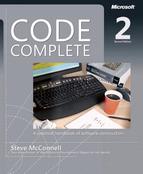Related Topics
Web resources: http://www.cc2e.com
If you've read this far, you already know that a lot has been written about effective software-development practices. Much more information is available than most people realize. People have already made all the mistakes that you're making now, and unless you're a glutton for punishment, you'll prefer reading their books and avoiding their mistakes to inventing new versions of old problems.
Because this book describes hundreds of other books and articles that contain information on software development, it's hard to know what to read first. A software-development library is made up of several kinds of information. A core of programming books explains fundamental concepts of effective programming. Related books explain the larger technical, management, and intellectual contexts within which programming goes on. And detailed references on languages, operating systems, environments, and hardware contain information that's useful for specific projects.
Books in the last category generally have a life span of about one project; they're more or less temporary and aren't discussed here. Of the other kinds of books, it's useful to have a core set that discusses each of the major software-development activities in depth: books on requirements, design, construction, management, testing, and so on. The following sections describe construction resources in depth and then provide an overview of materials available in other software knowledge areas. A Software Developer's Reading Plan wraps these resources into a neat package by defining a software developer's reading program.
I originally wrote this book because I couldn't find a thorough discussion of software construction. In the years since I published the first edition, several good books have appeared.
Pragmatic Programmer (Hunt and Thomas 2000) focuses on the activities most closely associated with coding, including testing, debugging, use of assertions, and so on. It does not dive deeply into code itself but contains numerous principles related to creating good code.
Jon Bentley's Programming Pearls, 2d ed. (Bentley 2000) discusses the art and science of software design in the small. The book is organized as a set of essays that are very well written and express a great deal of insight into effective construction techniques as well as genuine enthusiasm for software construction. I use something I learned from Bentley's essays nearly every day that I program.
Kent Beck's Extreme Programming Explained: Embrace Change (Beck 2000) defines a construction-centric approach to software development. As Importance of Prerequisites explained, the book's assertions about the economics of Extreme Programming are not borne out by industry research, but many of its recommendations are useful during construction regardless of whether a team is using Extreme Programming or some other approach.
Cross-Reference
For more in the economics of Extreme Programming and agile programming, see cc2e.com/3545.
A more specialized book is Steve Maguire's Writing Solid Code – Microsoft's Techniques for Developing Bug-Free C Software (Maguire 1993). It focuses on construction practices for commercial-quality software applications, mostly based on the author's experiences working on Microsoft's Office applications. It focuses on techniques applicable in C. It is largely oblivious to object-oriented programming issues, but most of the topics it addresses are relevant in any environment.
Another more specialized book is The Practice of Programming, by Brian Kernighan and Rob Pike (Kernighan and Pike 1999). This book focuses on nitty-gritty, practical aspects of programming, bridging the gap between academic computer-science knowledge and hands-on lessons. It includes discussions of programming style, design, debugging, and testing. It assumes familiarity with C/C++.
Although it's out of print and hard to find, Programmers at Work, by Susan Lammers (1986), is worth the search. It contains interviews with the industry's high-profile programmers. The interviews explore their personalities, work habits, and programming philosophies. The luminaries interviewed include Bill Gates (founder of Microsoft), John Warnock (founder of Adobe), Andy Hertzfeld (principal developer of the Macintosh operating system), Butler Lampson (a senior engineer at DEC, now at Microsoft), Wayne Ratliff (inventor of dBase), Dan Bricklin (inventor of VisiCalc), and a dozen others.
